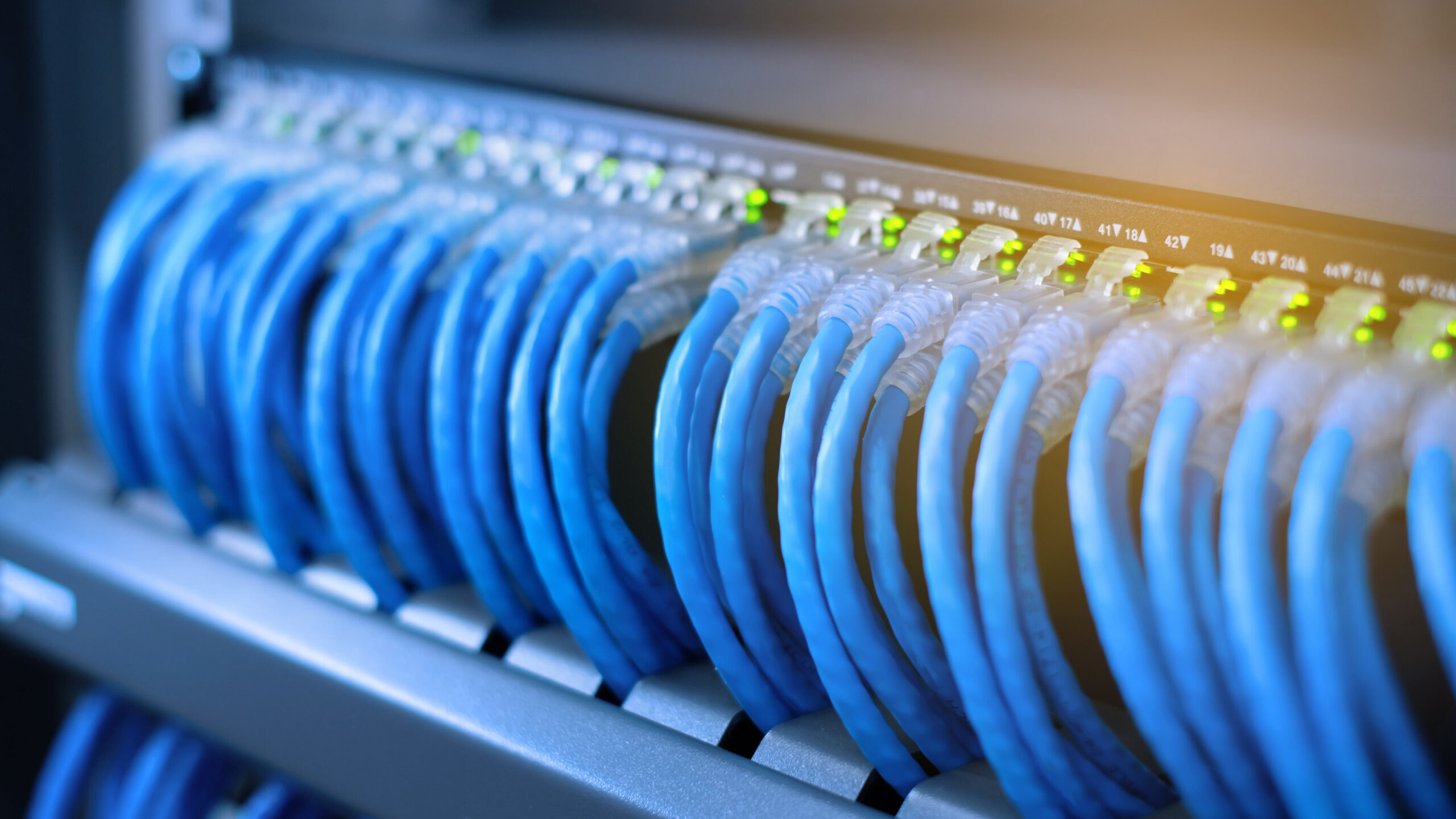In today’s digital age, the backbone of efficient networking lies in choosing the right cabling infrastructure. Two common contenders in this arena are Cat6 and Cat6a cables, each with its own set of features and capabilities. At Kent Cables, we recognise the significance of making informed decisions about your network infrastructure. Let’s delve deeper into the intricacies of Cat6 and Cat6a cabling to help you navigate through the complexities of networking solutions.
Defining Cat6 and Cat6a Cabling
Before exploring the distinctions, it’s essential to grasp the fundamental characteristics of Cat6 and Cat6a cables. Cat6 and Cat6a are both types of twisted pair cables designed to facilitate high-speed data transmission within Ethernet networks. They are built to handle the demands of modern networking environments, providing reliable connectivity and data transfer rates. Here’s a brief overview of each:
Cat6 Cabling
Cat6, short for Category 6, is a standardised twisted pair cable for Ethernet and other network physical layers that is backwards compatible with the Category 5/5e and Category 3 cable standards. It offers improved performance over its predecessors, particularly in terms of higher data transfer speeds and reduced crosstalk interference. Cat6 cables typically support bandwidths up to 250 MHz and are capable of transmitting data at speeds of up to 10 Gigabits per second (Gbps) over short distances. They are commonly used in commercial and residential networking applications where reliable high-speed connectivity is essential.
Cat6a Cabling
Cat6a, or Category 6a, is an enhanced version of Cat6 cabling, designed to support even higher data rates and longer transmission distances. The “a” in Cat6a stands for augmented or advanced, indicating its superior performance compared to Cat6. Cat6a cables feature improved shielding and thicker conductors, which reduce electromagnetic interference and enable them to support bandwidths of up to 500 MHz. This increased bandwidth allows Cat6a cables to transmit data at speeds of at least 10 Gbps over distances of up to 100 metres. Cat6a cabling is commonly used in applications requiring high-speed data transmissions, such as data centres, enterprise networks, and multimedia installations.
In summary, Cat6 and Cat6a cabling are both crucial components of modern networking infrastructure, offering high-speed connectivity and reliability for a wide range of applications. While Cat6 provides excellent performance for most networking needs, Cat6a offers enhanced capabilities, making it the preferred choice for demanding environments where future scalability and performance are paramount. So, what are the similarities and differences between Cat6 and Cat6a cabling? Read on to find out more…
The Similarities Between Cat6 and Cat6a Cabling
While Cat6 and Cat6a cables have distinct features, they share several similarities:
- Performance
Both Cat6 and Cat6a cables are engineered to support Gigabit Ethernet and, to some extent, 10 Gigabit Ethernet, ensuring robust performance in networking applications. Their high-performance capabilities guarantee efficient data transmission across networks of varying sizes and complexities.
- Structure
Structurally, both cables consist of four pairs of copper wires twisted together, a design aimed at reducing electromagnetic interference and signal degradation. This twisted pair configuration helps maintain signal integrity and minimises the risk of data corruption, ensuring reliable connectivity in diverse networking environments.
- Compatibility
Cat6 and Cat6a cables are backwards compatible with lower categories such as Cat5e and Cat5, providing versatility in network deployment and compatibility with existing infrastructure. This compatibility allows for seamless integration of Cat6 and Cat6a cables into existing network setups, facilitating smooth upgrades and expansions without the need for extensive reconfiguration.
The Differences Between Cat6 and Cat6a Cabling
To make an informed decision about your networking needs, it’s crucial to understand the disparities between Cat6 and Cat6a cables:
- Bandwidth
Cat6 cables typically support bandwidth up to 250 MHz, while Cat6a cables offer enhanced performance with support for up to 500 MHz, making Cat6a better suited for high-speed applications and future-proofing network infrastructure. The increased bandwidth of Cat6a cables enables them to accommodate growing data demands and emerging technologies, ensuring long-term compatibility and scalability.
- Speed
Cat6a cables boast higher speed capabilities, with support for at least 10 Gbps transmission, whereas Cat6 cables may encounter limitations in heavy cross-talk environments, potentially impacting performance at higher data rates. This higher speed capability of Cat6a cables makes them ideal for bandwidth-intensive applications and environments with demanding networking requirements, ensuring optimal performance and reliability.
- Distance
Cat6 cabling is limited to shorter transmission distances, typically up to 55 metres for 10GBASE-T applications, whereas Cat6a cables can extend up to 100 metres, providing greater flexibility in network design and deployment. The extended transmission distance of Cat6a cables allows for more expansive network configurations and eliminates the need for additional network infrastructure, reducing overall deployment costs and complexity.
The Importance of Choosing the Right Cabling Type
Selecting the appropriate cabling type for your networking infrastructure is a critical decision that can significantly impact the performance, reliability, and scalability of your network. Here are seven key points highlighting the importance of choosing the right cabling type:
- Performance Optimisation
The choice between Cat6 and Cat6a cabling directly affects the performance of your network. Opting for Cat6a cables ensures higher bandwidth and data transfer speeds, enabling smoother operation of bandwidth-intensive applications and reducing latency.
- Future-Proofing
Investing in Cat6a cabling future-proofs your network infrastructure by accommodating the increasing bandwidth demands of emerging technologies and applications. Cat6a’s higher performance capabilities provide scalability for future upgrades and expansions without the need for costly re-cabling.
- Reliability and Signal Integrity
Cat6a cables offer superior signal integrity and reduced electromagnetic interference compared to Cat6 cables. This enhanced reliability ensures consistent network performance and minimises the risk of data errors or packet loss, particularly in high-density networking environments.
- Longer Transmission Distances
Cat6a cables support longer transmission distances of up to 100 metres, compared to the 55-metre limitation of Cat6 cables for 10GBASE-T applications. This extended reach provides greater flexibility in network design and deployment, especially in larger commercial or industrial settings.
- Support for High-Speed Applications
Cat6a cabling’s ability to transmit data at speeds of at least 10 Gbps makes it ideal for high-speed networking applications, such as multimedia streaming, video conferencing, and data centre connectivity. Choosing Cat6a ensures optimal performance and reliability for demanding networking environments.
- Cost-Effectiveness in the Long Run
While Cat6a cables may entail higher upfront costs compared to Cat6 cables, their superior performance and longevity offer cost-effectiveness in the long run. The investment in Cat6a cabling pays off through reduced maintenance expenses, fewer network disruptions, and prolonged service life.
- Compliance with Industry Standards
Selecting the right cabling type ensures compliance with industry standards and regulations, guaranteeing interoperability with networking equipment and compatibility with existing infrastructure. Cat6a cabling meets or exceeds industry standards, providing peace of mind and assurance of network reliability and performance.
In conclusion, the importance of choosing the right cabling type cannot be overstated in today’s fast-paced digital landscape. Whether you opt for Cat6 or Cat6a cabling, prioritising performance, reliability, scalability, and compliance ensures a robust and future-ready network infrastructure capable of meeting the evolving demands of modern connectivity.
How are Cat6 and Cat6a Cables Installed?
The installation process for Cat6 and Cat6a cables shares many similarities, but there are specific considerations to ensure optimal performance and reliability for each type of cable. At Kent Cables, we follow strict guidelines and best practices, to ensure a smooth and effective installation of Cat6 and Cat6a cables, resulting in a reliable, high-performance network that meets your organisation’s connectivity needs. If you’d like to arrange for cat6 or cat6a cable installation, contact us today!
In Conclusion
In the realm of networking, the choice between Cat6 and Cat6a cabling holds significant weight, impacting the performance, reliability, and scalability of your network infrastructure. Both types of cables offer unique advantages and considerations that must be carefully weighed to meet the demands of your networking environment.
Cat6 cabling provides a solid foundation for many networking applications, delivering reliable performance and compatibility with existing infrastructure at a cost-effective price point. However, for environments requiring higher bandwidth, future-proofing, and enhanced performance, Cat6a emerges as the preferred choice. With its superior capabilities, including increased bandwidth, higher speed, and extended transmission distances, Cat6a cabling ensures optimal performance and scalability for high-speed networking applications.
At Kent Cables, we understand the importance of selecting the right cabling solution to meet your networking needs. Our expertise, premium-quality products, and tailored solutions empower you to build a robust and future-ready network infrastructure that meets the evolving demands of modern connectivity.
By carefully evaluating your performance requirements, budget considerations, and long-term goals, you can make an informed decision about whether Cat6 or Cat6a cabling is the right choice for your network. With the right cabling solution in place, you can create a resilient and efficient network that supports your organisation’s growth and success in today’s dynamic digital landscape.
FAQs About Cat6 and Cat6a Cabling
Q: Can Cat6a cables be used interchangeably with Cat6 cables?
A: While both cables are compatible, it’s recommended to use Cat6a cables for applications requiring higher bandwidth and future scalability.
Q: Are Cat6a cables more expensive than Cat6 cables?
A: Yes, Cat6a cables tend to be pricier due to their enhanced performance and capabilities.
Q: Can Cat6 and Cat6a cables be mixed in the same network?
A: While technically feasible, it’s advisable to maintain consistency within the network infrastructure to ensure optimal performance and compatibility.
Q: What are the key installation considerations for Cat6a cables?
A: Due to their thicker insulation and larger conductors, Cat6a cables may require special attention during installation to minimise signal degradation and interference.
Q: Are Cat6a cables backwards compatible with older networking equipment?
A: Yes, Cat6a cables are designed to be backwards compatible with devices supporting lower categories of Ethernet cabling, ensuring compatibility with existing infrastructure.
Q: What applications are best suited for Cat6 and Cat6a cables?
A: Both Cat6 and Cat6a cables are suitable for various networking applications, including commercial buildings, data centres, and residential networks, where high-speed data transmission is essential.
Q: Can Cat6a cables support Power over Ethernet (PoE) applications?
A: Yes, Cat6a cables are capable of supporting PoE applications, providing both data and power transmission over the network.
Q: What are the differences in shielding between Cat6 and Cat6a cables?
A: Cat6a cables typically feature enhanced shielding to mitigate electromagnetic interference, resulting in improved performance and reliability compared to Cat6 cables.
Q: How do I determine whether Cat6 or Cat6a cables are suitable for my network?
A: Consider factors such as anticipated bandwidth requirements, transmission distances, and budget constraints to make an informed decision about the most suitable cabling solution for your network.
Q: Can Cat6a cables support higher frequencies than 500 MHz?
A: While Cat6a cables are rated for up to 500 MHz, some variations may support frequencies exceeding this threshold, providing additional headroom for future network upgrades and expansions.
Q: How much does it cost to install Cat6 or Cat6a cabling?
A: The cost of Cat6 and Cat6a cable installation will vary depending on your requirements. For more information and to receive your FREE no-obligation quote, don’t hesitate to get in touch with us today.
Why Choose Kent Cables
- Industry Expertise
With years of experience in the networking industry, Kent Cables brings unparalleled expertise and knowledge to every project, ensuring optimal performance, reliability and cost-effectiveness.
- Quality Assurance
We are committed to delivering premium-quality Cat6 and Cat6a cables sourced from trusted manufacturers, guaranteeing superior performance and durability for your network infrastructure.
- Tailored Solutions
At Kent Cables, we understand that every network is unique. That’s why we offer customised solutions tailored to meet your specific requirements, ensuring seamless integration and maximum efficiency.
Elevate your networking infrastructure with Kent Cables today. Get in touch with us to discover how we can help you achieve your networking goals with our premium Cat6 and Cat6a cabling solutions.


